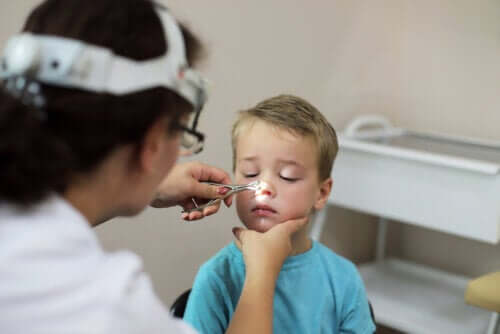What Are Dermoid Cysts in Children

Dermoid cysts are lumps that normally develop on the face or head. They can be present at birth or appear later on during childhood. In the article below, we’ll tell you all you need to know about dermoid cysts in children.
What are dermoid cysts?
A dermoid cyst is a benign congenital disease, meaning that children are born with it. Given their size, it may be difficult to detect these dermoid cysts in children until a few months later, when they’ve grown sufficiently. They’re embryonic in nature, which means they’re the result of an anomaly in fetal development.
Dermoid cysts are round tumors that can have different sizes and consistency. Most often, they appear on the face or head. However, they can actually appear on any part of the body.
What happens is that, during fetal development, in an area of the body, the layers of skin don’t grow together as they should. This causes there to be space – a hole under the skin – that ends up being occupied by other substances from the body. For example, sweat glands, sebaceous (old) glands, or hair follicles.

You may also want to read: Everything You Need to Know About Moles in Children
What are the symptoms of dermoid cysts in children?
Dermoid cysts are slow-growing tumors. They tend to be round and somewhat soft and it’s fairly easy to move the skin on their surface. What’s more, they tend to be the same color as the skin, although they may also have a slightly bluish tone.
These cysts don’t tend to produce any symptoms. However, since they usually appear on the face or head, there are certain risks involved. That’s because these are areas with a lot of nerves and structures.
The complications of dermoid cysts appear when, as they grow, they begin to affect other sensitive structures of the body. These complications are usually neurological or ophthalmological in nature.
Besides affecting other nearby areas, a cyst may also cause embarrassment of low self-esteem in children, depending on its location. This is another factor that’s important to consider when it comes to treatment. It’s also possible for the cyst to become infected and lead to abscesses, given the accumulation of substances in its interior.
Diagnosing dermoid cysts
As soon as you begin to notice something strange in your child, you should see a specialist. He or she will examine the cyst and the surrounding areas. And, if necessary, he or she may order some tests.

Besides the exploration and examination of the cyst, the specialist may also recommend X-rays, a CT scan, or an MRI. These tests may be necessary in order to determine if a child has a dermoid cyst or some other type of childhood tumor. What’s more, the tests also help define the exact location of the cyst and detect if it’s affecting the surrounding areas.
You may also want to read: Causes of Swollen Glands in Children
How to treat dermoid cysts in children
The treatment of dermoid cysts usually involves their removal by means of surgery. As always, it will be the specialist who decided when and how to carry out this procedure. Among other factors, it will depend on the size and location of the cyst, as well as the child’s age.
Dermoid cysts in children: What to keep in mind
Remember, dermoid cysts are benign and, normally, diagnosis and treatment take place without any major consequences. Therefore, there’s no need to worry excessively.
However, given their possible confusion with other types of childhood tumors, any time you notice that your child has a lump, you should see a specialist. This is true regarding new lumps as well as a previously existing lump that starts to grow – even if you had it looked at before. Your child’s doctor will be able to make proper diagnosis and indicate the correct course of treatment.
Dermoid cysts are lumps that normally develop on the face or head. They can be present at birth or appear later on during childhood. In the article below, we’ll tell you all you need to know about dermoid cysts in children.
What are dermoid cysts?
A dermoid cyst is a benign congenital disease, meaning that children are born with it. Given their size, it may be difficult to detect these dermoid cysts in children until a few months later, when they’ve grown sufficiently. They’re embryonic in nature, which means they’re the result of an anomaly in fetal development.
Dermoid cysts are round tumors that can have different sizes and consistency. Most often, they appear on the face or head. However, they can actually appear on any part of the body.
What happens is that, during fetal development, in an area of the body, the layers of skin don’t grow together as they should. This causes there to be space – a hole under the skin – that ends up being occupied by other substances from the body. For example, sweat glands, sebaceous (old) glands, or hair follicles.

You may also want to read: Everything You Need to Know About Moles in Children
What are the symptoms of dermoid cysts in children?
Dermoid cysts are slow-growing tumors. They tend to be round and somewhat soft and it’s fairly easy to move the skin on their surface. What’s more, they tend to be the same color as the skin, although they may also have a slightly bluish tone.
These cysts don’t tend to produce any symptoms. However, since they usually appear on the face or head, there are certain risks involved. That’s because these are areas with a lot of nerves and structures.
The complications of dermoid cysts appear when, as they grow, they begin to affect other sensitive structures of the body. These complications are usually neurological or ophthalmological in nature.
Besides affecting other nearby areas, a cyst may also cause embarrassment of low self-esteem in children, depending on its location. This is another factor that’s important to consider when it comes to treatment. It’s also possible for the cyst to become infected and lead to abscesses, given the accumulation of substances in its interior.
Diagnosing dermoid cysts
As soon as you begin to notice something strange in your child, you should see a specialist. He or she will examine the cyst and the surrounding areas. And, if necessary, he or she may order some tests.

Besides the exploration and examination of the cyst, the specialist may also recommend X-rays, a CT scan, or an MRI. These tests may be necessary in order to determine if a child has a dermoid cyst or some other type of childhood tumor. What’s more, the tests also help define the exact location of the cyst and detect if it’s affecting the surrounding areas.
You may also want to read: Causes of Swollen Glands in Children
How to treat dermoid cysts in children
The treatment of dermoid cysts usually involves their removal by means of surgery. As always, it will be the specialist who decided when and how to carry out this procedure. Among other factors, it will depend on the size and location of the cyst, as well as the child’s age.
Dermoid cysts in children: What to keep in mind
Remember, dermoid cysts are benign and, normally, diagnosis and treatment take place without any major consequences. Therefore, there’s no need to worry excessively.
However, given their possible confusion with other types of childhood tumors, any time you notice that your child has a lump, you should see a specialist. This is true regarding new lumps as well as a previously existing lump that starts to grow – even if you had it looked at before. Your child’s doctor will be able to make proper diagnosis and indicate the correct course of treatment.
All cited sources were thoroughly reviewed by our team to ensure their quality, reliability, currency, and validity. The bibliography of this article was considered reliable and of academic or scientific accuracy.
- Evaluación de tumoraciones cervicales en niños [Internet]. [cited 2020 Apr 9]. Available from: http://scielo.sld.cu/scielo.php?script=sci_arttext&pid=S0864-21251996000100006
- Lesiones de la línea media nasofrontal en niños [Internet]. [cited 2020 Apr 9]. Available from: http://www.scielo.org.pe/scielo.php?pid=S1727-558X2015000400009&script=sci_arttext
- Dermoid Cyst in Children [Internet]. [cited 2020 Apr 9]. Available from: https://www.stanfordchildrens.org/es/topic/default?id=dermoid-cyst-in-children-90-P05139
This text is provided for informational purposes only and does not replace consultation with a professional. If in doubt, consult your specialist.








